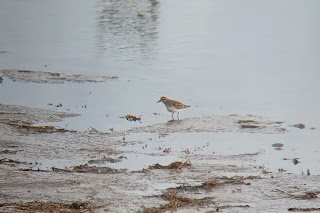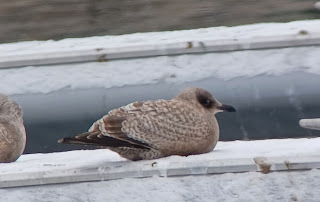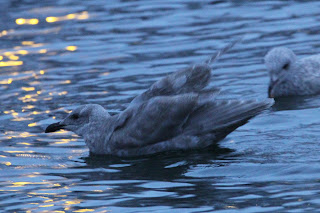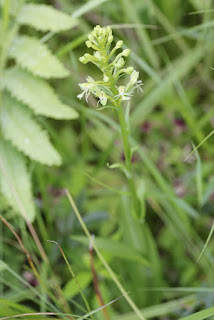On Friday, we made the trek to Algonquin Park for the annual odonate count. This year, I was assigned Area C, which includes the Big Pines Trail, Spruce Bog Boardwalk, Beaverpond Trail, and surrounding area. Due to regulations regarding social distancing, counters were not really able to mingle, so I had the entire area virtually to myself.
Our first stop was Big Pines Trail. This was one of the two spots I was asked to focus most of my time on. I spotted a few odes along the way, but the main attraction was a large open bog/meadow, and I spent a good hour at least tromping around through it.
I found a couple clubtails of note pretty quickly. Beaverpond Clubtail is a somewhat local but widespread ode in Algonquin Park. It has a pretty restricted range in Ontario, making it a specialty ode. I believe the species was first discovered in Ontario in Algonquin. As is typical with female clubtails, you need to check genital plates to confirm identity.
The other species of note was Harpoon Clubtail. This was my only one of the day.
The deerflies (Chrysops spp) were absolutely horrendous. I didn't wear any gloves at Big Pines, but later at Spruce Bog I found a pair of rubber gloves to put on, which certainly helped! The next morning when I woke up I found that one of my eyes was actually swollen shut as a result of the fly bites!
 |
| Chrysops montanus |
My main target in the bog was Ocellated Emerald, but I was unable to find any. Nevertheless, I still found a few interesting odes. I flushed a female Common Green Darner at one point, which is a scarce species in Algonquin during the summer, a new park ode for me. From what I gather, Bat Lake is one of the only reliable spots to see this species, and sure enough, a couple were seen there on count day. As well, one was seen at the pond at the logging museum.
 |
| Record shot |
There were a few baskettails around of three species. The only one I was able to net and photograph was Spiny Baskettail, but there were several Prince Baskettails flying around, as well as some Common Baskettails, which are easy to pick out as they have extensive dark hindwing patches in this part of Ontario.
 |
| Spiny Baskettail females have long appendages |
A new butterfly for me was Two-spotted Skipper. I saw a few on this day.
After failing to find any Somatochlora emeralds in the bog and donating a quart of blood to the insects, I made my way back to "dry land". Of course, as soon as I did that, I spotted one of these elusive emeralds. I managed to capture it (thank goodness, no one wants to miss a swing on a Somatochlora), and it proved to me a Williamson's Emerald. This is on the early side for the species, and proved to be a decent one for the count.
Next up was the Spruce Bog boardwalk. All of the good areas I was to check were off trail, so it required some bushwhacking. One of the first odes I caught was another Beaverpond Clubtail.
I also caught a fritillary, which proved to be an Atlantis Fritillary. I believe I saw a Silver-bordered or two as well.
I came across a couple Dragonhunters, which are quite the beasts. I wasn't really expecting to see any, so it was a pleasant surprise.
Finally I spotted a Somatochlora emerald, which proved to be a Ski-tipped Emerald when I netted it. I saw three in total.
 |
| The "ski tip" |
There were a couple of darners flying around, which I netted.
 |
| Canada Darner |
 |
| Springtime Darner |
I was on the lookout for Subarctic Bluet, but it appeared to be too late in the season for them. I did however find a Taiga Bluet, which is getting late. Another new park species for me.
An attractive species of orchid found in the bog is Rose Pogonia (Pogonia ophioglossoides).
I moved to a different section of the bog. I spotted an emerald, but it was too high up to try and catch. I have suspicions it was a Delicate Emerald though. I also spied this Virgin Tiger Moth, which was a new one for me.
I worked along the little creek that ran through, and picked up another Ski-tipped Emerald, as well as a Sphagnum Sprite. I spotted a large dark dragonfly at one point, and netted it. I was absolutely flabbergasted when I pulled out a Harlequin Darner!
Ever since I had first read about this species five years ago in my Algonquin Park odonate field guide, it was one of my most sought after odes. The only trouble is that it is an early flying species, and for the most part is done by the beginning of July. As such, it is not every odonate count that it is recorded (I don't have an exact number, but I think it might be around only 20% of counts it is observed). Since it is an early flier, I have not had the opportunity to go and try to see one. There are spots in southwestern Ontario where they occur, but I really wanted to find my first one in Algonquin Park, since that's sort of where it all began. My highlight of the day for sure.
I left Spruce Bog very happy, and made my last major stop of the day at the Beaver Pond Trail. I had only ever been to this trail once before in September a few years ago, but it is a pretty neat place.
Before I even got down to the pond, I spotted this orchid. It is the flavida form of Western Spotted Coralroot (Corallorhiza maculata var. occidentalis). I haven't seen very many coralroots myself, so it was quite neat.
Another interesting plant was White-edged Sedge (Carex debilis var. rudgei). This was my first time seeing it, although I undoubtedly have overlooked it in the past.
I didn't take a single picture of an odonate at this spot, but I added Elegant Spreadwing to the day's list. I'm basically positive I also had a Swamp Spreadwing, which is uncommon in Algonquin, but I wasn't able to confirm it. Oh well, at least I already have it for my park list! In lieu of ode pictures here is a consolation sedge.
 |
| Bronze Sedge (Carex foenea) |
I made a quick stop at Costello Creek before heading to the Opeongo Docks for the compilation. I added a couple Eastern Forktails to my day list, but not much else.
After the compilation (70 species tallied), we had to begin the drive back home to London. I made a quick stop at Pewee Lake just before leaving the park. I was hoping for Swamp Spreadwing (I had some here last year), but no luck. I did see a few Vesper Bluets, which was new for the day.
I spotted a new sedge for me, Northeastern Sedge (Carex cryptolepis), which can be similar to Yellow-green Sedge (C. flava), but is smaller and doesn't have dark edged pistillate scales.
Another one that was interesting was Blue Ridge Sedge (C. lucorum), which is undoubtedly underreported. It is very similar to Pennsylvania Sedge (C. pensylvanica), but has longer beaked perigynia. I have also heard that Blue Ridge Sedge has rougher (scabrous) culms than Pennsylvania Sedge, but that may not be entirely reliable.
These plants were infected by a smut fungus, potentially Anthracoidea caricis.
 |
| You can also see the long beaked perigynia! |
Great day in the park doing what I love!









































































